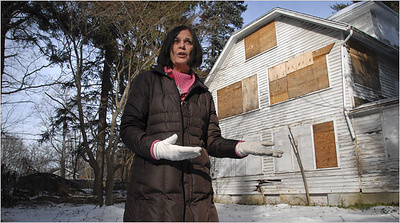By Cara, Feministe
It looks like the rates of homelessness among female veterans are rising (Female Veterans Among the Homeless)
Even including the 20 or so beds that would make up the new women’s home, Ms. Kiss described a grim calculus for female veterans. Ten years ago, women represented 3 percent of homeless veterans, she said, compared with 5 percent now. About 180,000 female troops now serve in Iraq and Afghanistan.
Of course, it’s still important to note that the vast majority of homeless veterans are male, and the number of homeless female veterans is rather disproportionately low compared to their numbers in the military overall. But the bad news is, first, their numbers just may rise when they finally come home from Iraq and Afghanistan. And second, there are fewer services out there to cater to them:
A Far-reaching network of private and public agencies serves homeless veterans in Connecticut, with group homes and caseworkers helping former military members live normally again.

But that network now faces the fallout from a signal change in the nation’s military policy — namely, the shift to female combatants. The number of homeless female veterans is also growing, with fewer resources to help them.
Earlier this month, though, an organization that runs two group homes for homeless male veterans in Bridgeport sought to build a similar facility in Norwalk for women.
The organization, the Applied Behavioral Rehabilitation Institute, was outbid in its effort to buy city land for the project, but the leaders of the initiative said that if it did not happen in Norwalk, they would find someplace else.
And Lord knows that unless President Barack Obama makes some incredibly significant changes, the Department of Veterans Affairs won’t be looking after them.
The biographical information of one of the homeless women interviewed for the article also made me take pause and consider that there might be a connection between the sexual violence epidemic in the military and female veteran homelessness.
Seventy-six percent of homeless veterans experience drug, alcohol or mental health problems; and while combat on its own can certainly be enough to bring about these issues, we know that sexual violence is also an indicator for substance abuse, depression and post-traumatic stress disorder. Statistics from Stop Military Rape seem to back up my hunches.
Yes, I do have a point, and it’s this: The rates of homelessness, not to mention substance abuse, trauma and other lasting impacts of combat, need to be dealt with across the board, for both men and women. But the solutions might not be the same across the board, because the causes might be different. And in working out solutions to this problem — real, long-term solutions that go beyond the necessity of providing beds for people to sleep in — that needs to be taken into account.
Cara blogs regularly at The Curvature and Feministe.
© 2009 Feministe All rights reserved.
ATTENTION READERS
We See The World From All Sides and Want YOU To Be Fully InformedIn fact, intentional disinformation is a disgraceful scourge in media today. So to assuage any possible errant incorrect information posted herein, we strongly encourage you to seek corroboration from other non-VT sources before forming an educated opinion.
About VT - Policies & Disclosures - Comment Policy



